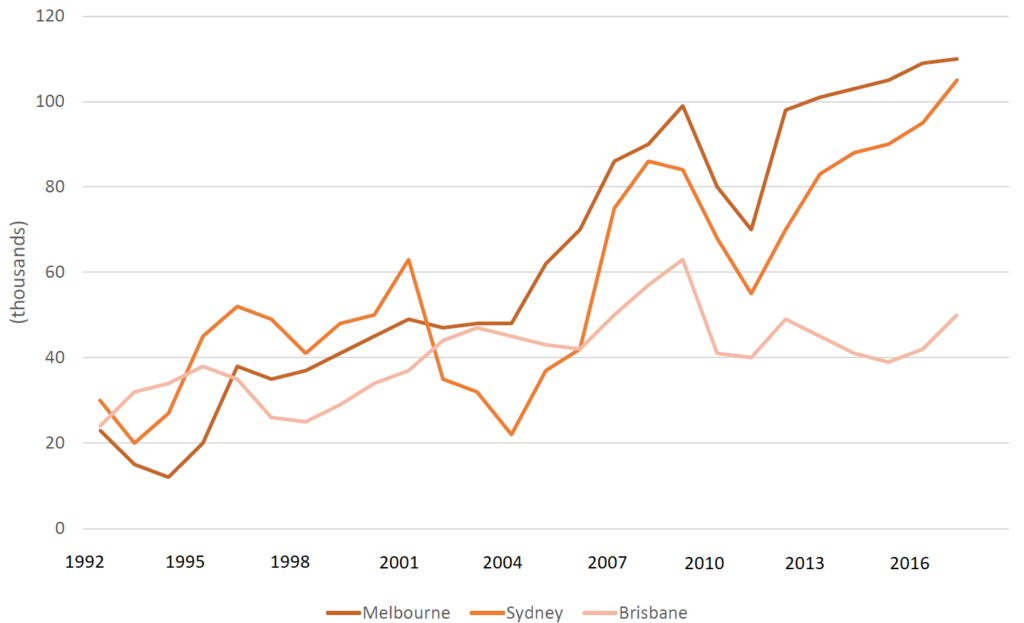
On IELTS test day, you may encounter line graphs in the Academic Writing Task 1 section. To help you understand what components make up a good response to a line graph question, let’s take a look at a model band 9 essay.
To see why this essay is band 9, see our scorer commentary after the model essay below, and check out the official IELTS rubric for Task 1 (PDF).
This particular prompt is a line graph. Your approach to this graph should be the same as your approach to any other Task 1 infographic Take a look at the information and think carefully. What is the best way to summarize the way the information is structured and the main points? From there, how can you best compare the most relevant pieces of information? Finally, how should you structure that summary and comparison? For more advice on how to approach this, see our article on IELTS Academic Task 1 paragraph structure, as well as our main page for IELTS sample questions and practice resources.
Try to do this prompt yourself. Then check out our band 9 model essay below the prompt and compare it to your own work to see how you did.
Model IELTS Academic Writing Task 1 Prompt: Line Graph
The chart below gives information about population growth in three major Australian cities from 1992 to 2016.
Summarise the information by selecting and reporting the main features and make comparisons where relevant.

Model Essay
This line graph shows the change in population for the cities of Melbourne, Sydney, and Brisbane from 1992 to 2017.
While all cities saw a net increase in annual population growth by 2011, the most dramatic increases happened between 2007 and 2010. In spite of this overall trend, there were a number of rises and falls in growth, with all cities showing a decrease in growth in 2011.
Although it started out with the least annual growth, Melbourne’s growth accelerated the most overall, starting with only a roughly 23k increase in people in 1992, but gaining around 110,000 people in 2017. Brisbane started out with nearly as little growth as Melbourne, but had a lower net gain, rising from slightly over 23k growth in 1992 to a gain of merely 50,000 by 2017. Sydney started out with the highest growth rate at 30,000 in a year, but ended with 105,000 annual growth by the end of the period, just behind Melbourne.
Why does this essay have a band 9 score?
All of Magoosh’s model IELTS Academic Writing Task 1 essays are meant to be band 9. But this model essay is special. Here, we’re going to give you a detailed explanation as to why this is a band 9 essay! Our scoring rationale is based on the band 9 category descriptors in the official rubric for Writing Task 1.
Task achievement
Per the instructions, this essay summarizes the information by identifying the main features in paragraph one, reporting the general content of the main features in paragraph two, and making relevant comparisons between the cities in the graph in paragraph three. This matches the band 9 descriptor “fully satisfies all the requirements of the task.
The essay organizes its paragraphs clearly, identifying the characteristics of the graph in the first paragraph, reporting the main features in the second, and making comparisons in the third. Each paragraph’s ideas are connected with appropriate linking words, such as “while,” “in spite of,” “although,” and so on. This matches with “clearly presents a fully developed response” in the band 9 task achievement section.
Coherence and cohesion
Coherence and cohesion are tied closely to the points I mentioned above in task achievement. This essay organizes similar ideas closely together in paragraphs without any distracting less relevant details and uses natural-sounding transitions. In doing this, the essay “uses cohesion in such a way that it attracts no attention” and “skillfully manages paragraphing.”
Lexical resource
While this essay does repeat sum specialized terms related to the graph, such as “annual,” it uses a variety of language to describe the same thing when possible. As one example, when describing the beginning point on the graph for each of the three cities in the final paragraph, the essay uses the terms “started out,” “began,” and “initially had.” The means that the essay “uses a wide range of vocabulary,” per level 9 of the rubric.
Not only are the words varied, but they are also very suited to the context and meaning. For instance, sophisticated phrasing such as “net increase” and “the most dramatic increases” appear in paragraph 1. Overly wordy terms such as “the total increase for each year combined” are avoided for the most part. So are slightly awkward-sounding phrases like “the very shocking increases.”
Moreover, the mistakes in word use that do appear in the essay are minor. “Amounts of people” in the first paragraph is overly simple and slightly awkward, but the essay uses the much better term “population” after that initial slip. Similarly, the use of the term “trending” when “trends” would be a more commonly used word with more accurate meaning, is a very minor word form error.
Ultimately, this links to the rubric’s description of “very natural and sophisticated control of lexical features,” where “rare minor errors occur only as “slips.”
Grammatical range and accuracy
This essay shows a level of grammar variety that’s comparable to its variety of vocabulary. The first paragraph consists of a sentence with a relatively simple structure, but with a sophisticated prepositional phrase modifying the noun “change.” The paragraphs that follow have compound sentences (the first sentence of paragraph 2), and the use of a variety of modifying phrases (ex: “with all cities…”, “rising from slightly…”).
There is a minor error in parallel structure in the first sentence of the second paragraph, with a shift from present participle “starting” to past tense “gained.”
Together, these aspects of grammar in the essay satisfy the level 9 rubric descriptor “uses a wide range of structures with full flexibility and accuracy; rare minor errors occur only as ‘slips’.”
More Practice IELTS Academic Writing Task 1 Sample Questions and Model Essays
- IELTS Academic Writing Task 1: Process Diagram with Model Answer
- IELTS Academic Writing Task 1: Bar Chart With Model Answer
- IELTS Academic Writing Task 1: Map With Model Answer
- IELTS Academic Writing Task 1: Pie Chart with Model Answer
- IELTS Academic Writing Task 1: Comparing two Graphics with Model Answer





